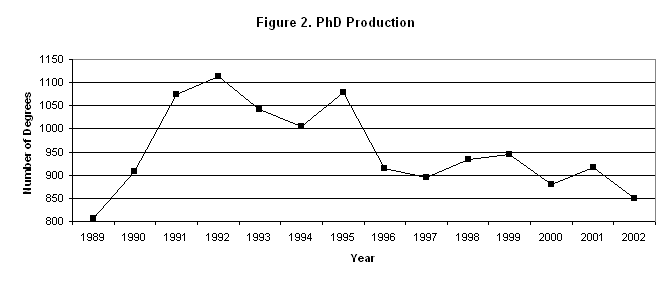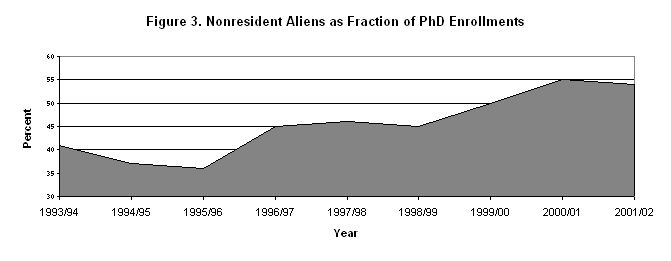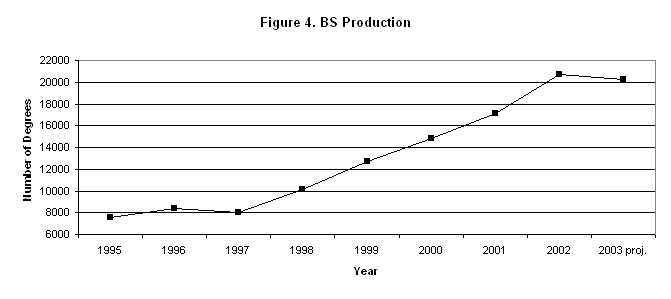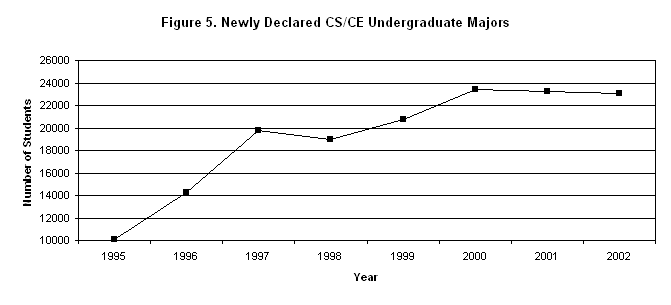THIS IS AN ARCHIVED VERSION OF CRA'S WEBSITE. THIS ARCHIVE IS AVAILABLE TO PROVIDE HISTORICAL CONTENT.
PLEASE VISIT HTTP://WWW.CRA.ORG FOR THE LATEST INFORMATION
| About CRA |
| Membership |
| CRA for Students |
| CRA for Faculty |
| CRA-Women |
| Computing Community Consortium (CCC) |
| Awards |
| Projects |
| Events |
| Jobs |
| Government Affairs |
| Computing Research Policy Blog |
| Publications |
| Data & Resources |
| CRA Bulletin |
| What's New |
| Contact |
| Home |
<< Back to March 2003 CRN Table of Contents
[Published originally in the March 2003 edition of Computing Research News, Vol. 15/No. 2, pp. 6-13.]
[This version of the article is meant for online viewing. Please use the PDF for printing]
2001-2002 Taulbee Survey
Survey Results Show Better Balance in Supply and Demand
By Moshe Y. Vardi, Tim Finin, and Tom Henderson
This article and the accompanying figures and tables present the results of the 32nd annual CRA Taulbee Survey1 of Ph.D.-granting departments of computer science (CS) and computer engineering (CE) in the United States and Canada. This survey is conducted annually by the Computing Research Association to document trends in student enrollment, employment of graduates, and faculty salaries.
Information is gathered during the fall and early winter. The period the data cover varies from table to table. Degree production (Ph.D., Master's, and Bachelor's) and total Bachelor's, Master's and Ph.D. enrollments refer to the previous academic year (2001-2002). Data for new students in all categories refer to the current academic year (2002-2003). Projected student production and information on faculty salaries and demographics also refer to the current academic year. Faculty salaries are those effective January 1, 2003. Responses received by January 3, 2003 are included in the analysis.
The data were collected from Ph.D.-granting departments only. A total of 225 departments were surveyed, compared with 215 departments last year. As shown in Figure 1, 182 departments returned their survey forms, for a response rate of 80 percent (the same as last year). The return rate of 10 out of 28 (36%) for Computer Engineering (CE) programs is very low, as has been the case for several years (see below). We attribute this low response to two factors: 1) many CE programs are part of an ECE department, and they do not keep separate statistics for CE vs. EE; and 2) many of these departments are not aware of the Taulbee Survey or its importance. The response rate for US CS departments (150 of 170, or 88%) was very good, as was the 82% response rate for Canadian programs. We thank all respondents who completed this year's questionnaire. Departments that participated are listed at the end of this article.
The set of departments responding is somewhat different each year (10 more departments responded this year); thus, we must approach any trend analysis with caution. Due to the low return rate for CE departments, the same caveat applies to the CE data. In our discussion, we will focus on the combined numbers for CS and CE. Because of the low return rate for CE, the CRA board has decided to combine the CS and CE data in future Taulbee Surveys and not offer separate data for CE.
For more details on how the faculty salary information (Tables 27-34) is to be interpreted, see the article in the January 2003 CRN on Preliminary Taulbee Faculty Salary Data (/CRN/articles/jan03/vardi.finin.henderson.html).
The survey form itself is modified slightly each year to ensure a high rate of return (e.g., by simplifying and clarifying), while continuing to capture the data necessary to understand trends in the discipline and also reflect changing concerns of the computing research community. In previous years, Tables 27-34 have only reported the mean salaries. We believe, however, that for aggregating data the median is more meaningful than the mean, since it is less skewed by outlying data points. This year we have included both mean and median salaries to facilitate comparison with previous Taulbee Surveys. In future surveys, however, we intend to report only median salaries. Departments will be asked to provide only the minimum, median, and maximum salaries.
Ph.D. Degree Production and Enrollments (Tables 1-8)
As shown in Table 1, a total of 849 Ph.D. degrees were awarded in 2002 by the 182 responding departments. As Figure 2 indicates, this is the lowest number since 1989. Most likely this number is still reflecting the high-tech boom of the late 1990s, when start-up companies presented an extremely attractive employment option for computer scientists.

The prediction from last year's survey that 1,205 Ph.D. degrees would be awarded in 2002 was, as usual, overly optimistic, with an "optimism" ratio, defined as the actual over the predicted, being 0.70. Given next year's prediction of 1,224 graduates (Table 1), we predict the actual number will be between 850 and 950.
All other numbers indicate a strong growth in the Ph.D. supply in the next few years. The number entering Ph.D. programs (Table 5) increased from 2,702 to 3,286 (22%). The number who passed qualifiers (Table 1) increased from 1,244 to 1,375 (11%), but the number who passed thesis proposal exams (Table 1) decreased slightly from 917 to 884 (-4.0%). Total Ph.D. enrollment (Table 6) increased from 8,810 to 10,021 (14%). Looking beyond our survey results, some CS programs are reporting record numbers of applicants to their Ph.D. programs this year. It seems that the failure of the dot-com boom has convinced many recent Bachelor's and Master's degree recipients to return to graduate school.
Table 4 shows area of specialization versus types of first appointments for Ph.D. recipients in 2002. The table shows a marked shift from industrial to academic employment. More than 52% of fresh Ph.D.s found academic employment (43% last year) and only 38.2% found industrial employment (49% last year). There has also been a non-negligible increase in the number of postdoctoral positions (from 56 to 83).
Most statistics on gender and ethnicity for Ph.D. students (Tables 2, 3, 7, 8) show remarkably little change from last year. White and nonresident-alien men continue to account for a very large fraction of our Ph.D. production and enrollments. Women constitute a significant minority (19% of enrollments, 18% of graduates.) All other underrepresented groups are very small minorities. As Figure 3 illustrates, we see a slight decrease in the proportion of enrolled Ph.D. students who are nonresident aliens, probably reflecting an increased interest in Ph.D. programs by U.S. students.

Master's and Bachelor's Degree Production and Enrollments (Tables 9-16)
The statistics on Master's and Bachelor's programs show mixed trends. Master's degrees were awarded to 7,918 students, a decrease of 4 percent from last year. Bachelor's degrees numbered 20,677, an increase of 21 percent. This year's Master's production exceeded the projection from last year's survey by 8 percent, while Bachelor's production exceeded projections by 11 percent.

The number of new undergraduates actually dropped slightly from 23,090 to 23,033 (0%) (see Figure 5), in contrast with significant increases in recent years. As yet, we cannot determine whether this was simply an artifact of the changes in the departments reporting, or the start of a new trend. Perhaps the decline in the technology industry is making computer science and engineering less alluring to new undergraduates. In addition, some programs may be operating in "saturation" mode, where they simply cannot accept more undergraduate majors, given their teaching resources. It is quite clear that the period of explosive growth in enrollments in Bachelor's programs is over. Anecdotal evidence suggests that the trend of increasing enrollments is near its peak, and is perhaps headed towards a decline.

In all other numbers, we again see mixed trends in both Bachelor's and Master's programs. New Master's students (Table 13) decreased by 3% percent; total enrollments in Bachelor's programs (Table 16) increased by 11% and enrollments in Master's programs (Table 15) increased by 21%. We seem to be in a period of changing patterns in all degree programs; it may take a while before the new trends are clear.
Most demographics regarding gender and ethnicity for Bachelor's and Master's students show remarkable stability when compared with last year's results. As with Ph.D. recipients (whose numbers actually decreased this year), the proportion of Master's degree recipients who are nonresident aliens decreased slightly, from 57 percent last year to 56 percent this year (Table 10).
Faculty Demographics (Tables 17-23)
Over the past year, the total number of faculty increased by 3 percent to a total of 5,520. This increase was present in all faculty categories (but not for researchers or postdocs). Considering that 229 faculty are reported to have left their current positions in academia (Table 23), the survey indicates 405 new faculty positions this year. Our Ph.D. production shows only 351 graduates taking faculty positions (Table 4). Some of the new teaching faculty may not have Ph.D. degrees, and some new faculty may have come from nonacademic sources. There is some influx of existing Ph.D.-holders into academia as industrial labs are being downsized and reorganized.
This year's faculty growth to 5,520 was less than the prediction of 5,955 from last year's survey. The planned two-year growth rate of 14 percent is significantly less than last year's 21 percent. The projected target of 5,881 positions for 2003-04 reflects growth of less than 7 percent. Last year we observed that the planned growth targets were unrealistically aggressive, compared with the predicted supply of new Ph.D.s. This year, the combination of increasing supply (because of the increased attractiveness of academia) and decreasing targets makes the recruiting objectives seem more feasible, although the tough economic environment suggests that even 7% growth is perhaps too optimistic.
Table 23 on faculty "losses" shows that a large number took academic positions elsewhere. Only 89 (1.6% of total faculty) actually left academia through death, retirement, or taking nonacademic positions. This compares with 140 (2.6% of total faculty) last year. Overall, the rate of departures over the past few years has remained within the very stable range of between 1.6 percent and 2.6 percent. The faculty "retention problem" that was so much discussed over the past few years seems to have solved itself.
The demographic data for faculty (Tables 19-22) are very similar to those from last year. We see that the gender split of new faculty (82% male, 18% female) is very close to the split for new Ph.D. recipients (Table 2). There is some skew in the distribution, with somewhat more men in tenure-track (83%) and research (89%) positions, and somewhat more women in teaching (26%) and other (60%) positions, but these numbers are actually more balanced than in previous years.
It is interesting to compare the ethnicity data for new faculty (Table 20) with that of Ph.D. recipients (Table 3). Fully 55 percent of the new faculty are white, non-Hispanic, even though only 37 percent of the Ph.D. recipients are in this category. By contrast, only 23 percent of the new faculty are nonresident aliens, whereas fully 47 percent of the degree recipients are in that category. Some new faculty could have become residents after receiving their Ph.D. degrees, but it seems clear that proportionately fewer foreign students take positions at U.S. universities.
Research Expenditures and Graduate Student Support (Tables 24-26)
The first question asked: "For the most recently completed fiscal year, what was the department's total expenditure (including indirect costs or "overhead" as stated on project budgets) from external sources of support for Computer Science/Engineering research?" The results are reported in Table 24, showing both absolute and per-capita numbers, where capitation is computed relative to the number of tenured and tenure-track faculty members. Canadian levels are shown in Canadian dollars. The data show a clear correlation between ranking and per-capita expenditures, although this correlation holds only between ranking bands (1-12, 13-24, etc.) and per-capita expenditures. As expected, Canadian departments show a lower level of expenditures from external sources, stemming, no doubt, from the different way that research is funded in Canada. Computer engineering departments also show a lower level of expenditures from external sources, but no conclusion can be drawn due to the low response rate of computer engineering departments.
The second question asked departments to "provide the number of graduate students supported as full-time students as of fall 2002," further categorized as teaching assistants, research assistants, fellows, or computer systems' supporters, and split between those on institutional vs. external funds. The results are shown in Table 25. Overall, we can see that the higher-ranked schools are able to support more students with research positions through research assistantships and fellowships, while the other schools rely more on teaching assistantships to support their students. Canadian schools also have a high proportion (52%) of students supported via teaching assistantships. The number supported for computer systems support is very small.
The third question asked respondents to "provide the net amount (as of fall 2002) of an academic-year stipend for a graduate student (not including tuition or fees)." The results are shown in Table 26. Canadian stipends are shown in Canadian dollars. The numbers suggest a gap between departments in the top two ranking bands and departments in lower bands in all categories of graduate-student support.
Faculty Salaries (Tables 27-34)
U.S. average salaries increased by just over 3 percent for different categories, less than last year's increases (average salaries for non-teaching faculty actually declined slightly). Canadian salaries (shown as 12-month salaries in Canadian dollars) increased by 3.8% to 5.2% for different categories, less than for last year (again with a slight decrease for non-teaching faculty).
Concluding Observations
Overall, signs indicate a continued growth in graduate (both Master's and Ph.D.) programs in computer science and engineering. Although Ph.D. output declined slightly this year, it appears there will be a significant increase over the next few years. The growth at the Bachelor's level has diminished compared with recent years, with even a slight decrease in the number of newly declared majors. It is still too early to tell whether this is the start of a trend toward declining undergraduate enrollments (as has happened at other times during downturns in the technology economy), whether it simply indicates that many programs are operating at full capacity and cannot expand further, or whether it is just an artifact of the shifting departments responding to our survey. We suspect, however, that this is the start of a trend toward declining enrollments.
Rankings
For tables that group computer science departments by rank, the rankings are based on information collected in the 1995 assessment of research and doctorate programs in the United States conducted by the National Research Council [see /statistics/nrcstudy2/home.html].
The top twelve schools in this ranking are: Stanford, Massachusetts Institute of Technology, University of California (Berkeley), Carnegie Mellon, Cornell, Princeton, University of Texas (Austin), University of Illinois (Urbana-Champaign), University of Washington, University of Wisconsin (Madison), Harvard, and California Institute of Technology. All schools in this ranking participated in the survey this year.
CS departments ranked 13-24 are: Brown, Yale, University of California (Los Angeles), University of Maryland (College Park), New York University, University of Massachusetts (Amherst), Rice, University of Southern California, University of Michigan, University of California (San Diego), Columbia, and University of Pennsylvania.2 All schools in this ranking participated in the survey this year.
CS departments ranked 25-36 are: University of Chicago, Purdue, Rutgers, Duke, University of North Carolina (Chapel Hill), University of Rochester, State University of New York (Stony Brook), Georgia Institute of Technology, University of Arizona, University of California (Irvine), University of Virginia, and Indiana. All schools in this ranking participated in the survey this year.
CS departments that are ranked above 36 or that are unranked that responded to the survey include: Arizona State University, Auburn, Boston, Brandeis, Case Western Reserve, Clemson, College of William and Mary, Colorado School of Mines, Colorado State, Dartmouth, DePaul, Drexel, Florida Institute of Technology, Florida International, Florida State, George Mason, George Washington, Georgia State, Illinois Institute of Technology, Iowa State, Johns Hopkins, Kansas State, Kent State, Lehigh, Louisiana State, Michigan State, Michigan Technological, Mississippi State, Montana State, New Jersey Institute of Technology, New Mexico State, North Carolina State, North Dakota State, Northeastern, Northwestern, Oakland, Ohio State, Oklahoma State, Old Dominion, Oregon Health & Science, Oregon State, Pennsylvania State, Polytechnic, Portland State, Rensselaer Polytechnic, Southern Methodist, State University of New York (Albany and Buffalo), Stevens Institute, Syracuse, Texas A&M, Texas Tech, Tufts, Utah State, Vanderbilt, Virginia Commonwealth, Virginia Polytechnic, Washington State, Washington (St. Louis), Wayne State, West Virginia, Western Michigan, Worcester Polytechnic, and Wright State.
University of: Alabama (Birmingham, Huntsville, and Tuscaloosa), Arkansas, California (at Davis, Riverside, Santa Barbara, and Santa Cruz), Central Florida, Cincinnati, Colorado (at Boulder, Colorado Springs, and Denver), Connecticut, Delaware, Denver, Florida, Georgia, Hawaii, Illinois (Chicago), Iowa, Kansas, Kentucky, Louisiana (Lafayette), Maine, Maryland (Baltimore Co.), Massachusetts (at Boston and Lowell), Minnesota, Missouri (at Rolla and Columbia), Nebraska (Lincoln), Nevada (Las Vegas), New Mexico, North Texas, Notre Dame, Oklahoma, Oregon, Pittsburgh, South Carolina, South Florida, Tennessee (Knoxville), Texas (at Arlington, Dallas, El Paso, and San Antonio), Tulsa, Utah, and Wyoming.
Computer Engineering departments participating in the survey this year include: Cornell, Georgia Institute of Technology, Johns Hopkins, North Carolina State, Northwestern, Oregon State, Purdue, Rensselaer Polytechnic, University of California (Santa Cruz), University of Illinois (Urbana-Champaign), and the University of New Mexico.
Canadian departments participating in the survey include: Carleton, Dalhousie, McGill, Memorial, Queen's, Simon Fraser, and York universities. University of: Alberta, British Columbia, Calgary, Laval, Manitoba, Montreal, New Brunswick, Quebec (Montreal), Regina, Saskatchewan, Toronto (CS and ECE), Victoria, Waterloo, and Western Ontario.
Acknowledgments
Jean Smith and Drew Sutter assisted with data collection, tabulation, and analysis for this survey. We thank them for their assistance. Randy Bryant and Stu Zweben participated in the discussion of the analysis, and provided useful suggestions for this document.
Endnotes
1. The title of the survey honors the late Orrin E. Taulbee of the University of Pittsburgh, who conducted these surveys for the Computer Science Board until 1984, with retrospective annual data going back to 1970.
2. Although the University of Pennsylvania and the University of Chicago were tied in the National Research Council rankings, CRA made the arbitrary decision to place Pennsylvania in the second tier of schools.
All tables with rankings: Statistics sometimes are given according to departmental rank. Schools are ranked only if they offer a CS degree and according to the quality of their CS program as determined by reputation. Those that only offer CE degrees are not ranked, and statistics are given on a separate line, apart from the rankings.
All ethnicity tables: Ethnic breakdowns are drawn from guidelines set forth by the U.S. Department of Education.
All faculty tables: The survey makes no distinction between faculty specializing in CS vs. CE programs. Every effort is made to minimize the inclusion of faculty in electrical engineering who are not computer engineers.
Copyright © 2007 Computing Research Association. All Rights Reserved. Questions? E-mail: webmaster@cra.org.
